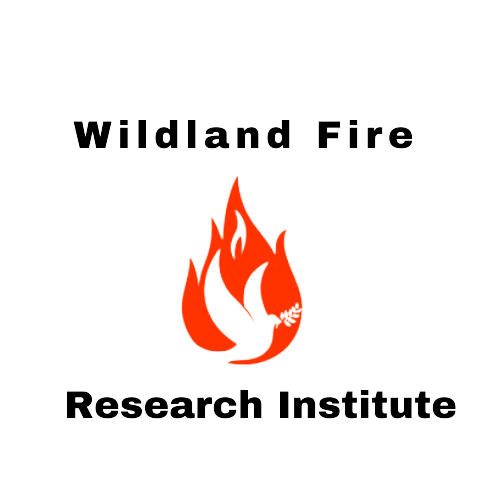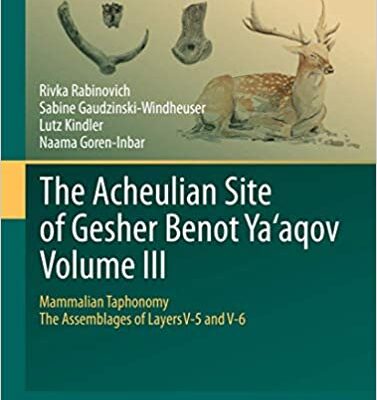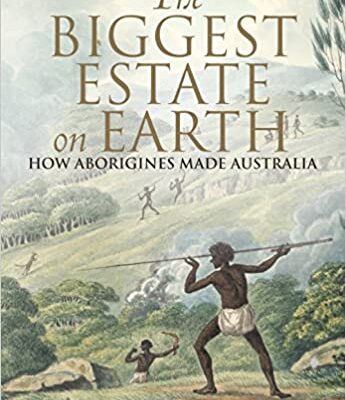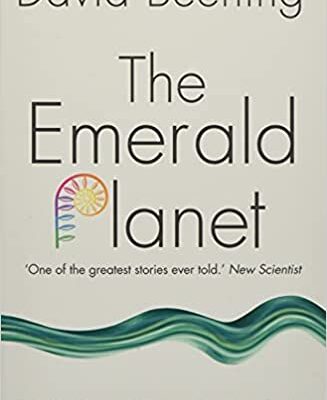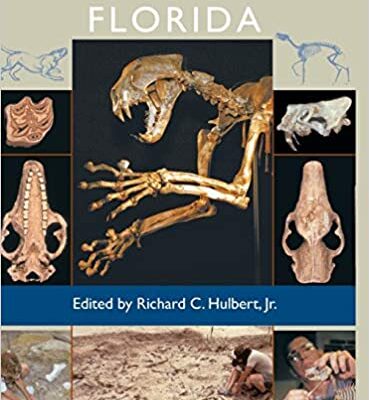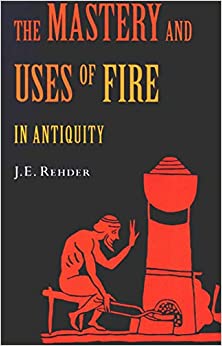Relict Species: Phylogeography and Conservation Biology
2010th Edition
2010th Edition
Sesselfelsgrotte III: Der G-Schichten-Komplex Der Sesselfelsgrotte. Zum Verstandnis Des Micoquien (Forschungsprojekt 'das Palaolithikum Und ... Altmuhltals II', Teil III) (German Edition)
Hardcover – April 9, 2008
German Edition by Jurgen Richter(Author)
Hardcover – April 9, 2008
German Edition by Jurgen Richter(Author)
The Acheulian Site of Gesher Benot Ya‘aqov Volume III: Mammalian Taphonomy. The Assemblages of Layers V-5 and V-6 (Vertebrate Paleobiology and Paleoanthropology)
2012th Edition
by Rivka Rabinovich(Author), Sabine Gaudzinski-Windheuser(Author), Lutz Kindler(Author), Naama Goren-Inbar(Author)
Multidisciplinary research on the Early-Middle Pleistocene site of Gesher Benot Ya‘aqov has yielded abundant climatic, environmental, ecological and behavioral records. The 15 archaeological horizons form a sequence of Acheulian occupational episodes on the shore of the paleo-Lake Hula. These enable us to reconstruct numerous aspects of the survival and adaptation of ancient hominins, leading to a better understanding of their evolution and behavior. This book presents the faunal analyses of medium-sized and large mammals, providing taxonomic, taphonomic and actualistic data for the largest faunal assemblages. The study of modes of animal exploitation reveals valuable information on hominin behavior
2012th Edition
by Rivka Rabinovich(Author), Sabine Gaudzinski-Windheuser(Author), Lutz Kindler(Author), Naama Goren-Inbar(Author)
Multidisciplinary research on the Early-Middle Pleistocene site of Gesher Benot Ya‘aqov has yielded abundant climatic, environmental, ecological and behavioral records. The 15 archaeological horizons form a sequence of Acheulian occupational episodes on the shore of the paleo-Lake Hula. These enable us to reconstruct numerous aspects of the survival and adaptation of ancient hominins, leading to a better understanding of their evolution and behavior. This book presents the faunal analyses of medium-sized and large mammals, providing taxonomic, taphonomic and actualistic data for the largest faunal assemblages. The study of modes of animal exploitation reveals valuable information on hominin behavior
The Acheulian Site of Gesher Benot Ya’aqov Volume II: Ancient Flames and Controlled Use of Fire (Vertebrate Paleobiology and Paleoanthropology)
2010th Edition
2010th Edition
The Biggest Estate on Earth: How Aborigines Made Australia
Paperback – April 1, 2013
by Bill Gammage (Author)
Across Australia, early Europeans commented again and again that the land looked like a park, with extensive grassy patches and pathways, open woodlands, and abundant wildlife. Bill Gammage has discovered this was because Aboriginal people managed the land in a far more systematic and scientific fashion than most people have ever realized. For more than a decade, he has examined written and visual records of the Australian landscape. He has uncovered an extraordinarily complex system of land management using fire, the life cycles of native plants, and the natural flow of water to ensure plentiful wildlife and plant foods throughout the year. Aboriginal people spent far less time and effort than Europeans in securing food and shelter, and this book reveals how. Once Aboriginal people were no longer able to tend their country, it became overgrown and vulnerable to the hugely damaging bushfires Australians now experience. With details of land-management strategies from around Australia, this book rewrites the history of the continent, with huge implications for today.
Paperback – April 1, 2013
by Bill Gammage (Author)
Across Australia, early Europeans commented again and again that the land looked like a park, with extensive grassy patches and pathways, open woodlands, and abundant wildlife. Bill Gammage has discovered this was because Aboriginal people managed the land in a far more systematic and scientific fashion than most people have ever realized. For more than a decade, he has examined written and visual records of the Australian landscape. He has uncovered an extraordinarily complex system of land management using fire, the life cycles of native plants, and the natural flow of water to ensure plentiful wildlife and plant foods throughout the year. Aboriginal people spent far less time and effort than Europeans in securing food and shelter, and this book reveals how. Once Aboriginal people were no longer able to tend their country, it became overgrown and vulnerable to the hugely damaging bushfires Australians now experience. With details of land-management strategies from around Australia, this book rewrites the history of the continent, with huge implications for today.
The Emerald Planet: How plants changed Earth's history (Oxford Landmark Science)
Paperback – April 23, 2017
by David Beerling (Author)
In The Emerald Planet, David Beerling puts plants centre stage, revealing the crucial role they have played in driving global changes in the environment, in recording hidden facets of Earth's history, and in helping us to predict its future. His account draws together evidence from fossil plants, from experiments with their living counterparts, and from computer models of the 'Earth System', to illuminate the history of our planet and its biodiversity. This new approach reveals how plummeting carbon dioxide levels removed a barrier to the evolution of the leaf; how plants played a starring role in pushing oxygen levels upwards, allowing spectacular giant insects to thrive in the Carboniferous; and it strengthens fascinating and contentious fossil evidence for an ancient hole in the ozone layer. Along the way, Beerling introduces a lively cast of pioneering scientists from Victorian times onwards whose discoveries provided the crucial background to these and the other puzzles. This understanding of our planet's past sheds a sobering light on our own climate-changing activities, and offers clues to what our climatic and ecological futures might look like. There could be no more important time to take a close look at plants, and to understand the history of the world through the stories they tell. Oxford Landmark Science books are 'must-read' classics of modern science writing which have crystallized big ideas, and shaped the way we think.
Paperback – April 23, 2017
by David Beerling (Author)
In The Emerald Planet, David Beerling puts plants centre stage, revealing the crucial role they have played in driving global changes in the environment, in recording hidden facets of Earth's history, and in helping us to predict its future. His account draws together evidence from fossil plants, from experiments with their living counterparts, and from computer models of the 'Earth System', to illuminate the history of our planet and its biodiversity. This new approach reveals how plummeting carbon dioxide levels removed a barrier to the evolution of the leaf; how plants played a starring role in pushing oxygen levels upwards, allowing spectacular giant insects to thrive in the Carboniferous; and it strengthens fascinating and contentious fossil evidence for an ancient hole in the ozone layer. Along the way, Beerling introduces a lively cast of pioneering scientists from Victorian times onwards whose discoveries provided the crucial background to these and the other puzzles. This understanding of our planet's past sheds a sobering light on our own climate-changing activities, and offers clues to what our climatic and ecological futures might look like. There could be no more important time to take a close look at plants, and to understand the history of the world through the stories they tell. Oxford Landmark Science books are 'must-read' classics of modern science writing which have crystallized big ideas, and shaped the way we think.
The Fossil Vertebrates of Florida
Hardcover – February 23, 2001
by Richard C. Hulbert Jr. (Author), Roger Portell (Illustrator)
"Hulbert’s book provides the first comprehensive review of the fossil vertebrates of Florida, which has one of the richest Cenozoic fossil records of any state in the country. It will be an essential addition to the library of all professional paleontologists, students, and amateurs interested in the history of fossil vertebrates in Florida and the southeastern United States."-- Gary S. Morgan, assistant curator of paleontology, New Mexico Museum of Natural History "A wonderful mix of technical, state-of-the-art information . . . with commentary on everyday fossils that all may have experienced at one time or another. The book is both for the serious student of vertebrate paleontology and for anyone who has an interest in the fossils that may be encountered in Florida."-- David P. Whistler, curator of vertebrate paleontology, Natural History Museum of Los Angeles County Illustrated with hundreds of photographs and drawings, this authoritative yet readable book describes the fossil vertebrates found in Florida—many unique to the state--and summarizes more than 100 years of paleontological discoveries and research. It bridges the sometimes disconnected worlds of the professional paleontologist and the avocational collector and hobbyist. Florida has the richest vertebrate fossil record of any state east of the Mississippi, extending back 45 million years. Beginning with an introduction to vertebrate anatomy, Richard Hulbert describes the geological history of the state and the history of vertebrate life in it. He then addresses such questions as what animals lived in Florida, how they are related to one another and to living animals, when they first appeared and when many of them became extinct, what they ate, and what they tell us about past environments. All types of vertebrates are covered, including sharks and other fish, amphibians, reptiles, birds, and mammals. In addition to exceptionally detailed illustrations (many published for the first time), the book includes a comprehensive list of every verified fossil species ever collected in Florida. Based on the popular Plaster Jacket series of pamphlets written by renowned natural scientists and published by the Florida Paleontological Society, The Fossil Vertebrates of Florida brings information from the last 30 years into an up-to-date, greatly expanded, cohesive book form.Hardcover – February 23, 2001
by Richard C. Hulbert Jr. (Author), Roger Portell (Illustrator)
"Hulbert’s book provides the first comprehensive review of the fossil vertebrates of Florida, which has one of the richest Cenozoic fossil records of any state in the country. It will be an essential addition to the library of all professional paleontologists, students, and amateurs interested in the history of fossil vertebrates in Florida and the southeastern United States."-- Gary S. Morgan, assistant curator of paleontology, New Mexico Museum of Natural History "A wonderful mix of technical, state-of-the-art information . . . with commentary on everyday fossils that all may have experienced at one time or another. The book is both for the serious student of vertebrate paleontology and for anyone who has an interest in the fossils that may be encountered in Florida."-- David P. Whistler, curator of vertebrate paleontology, Natural History Museum of Los Angeles County Illustrated with hundreds of photographs and drawings, this authoritative yet readable book describes the fossil vertebrates found in Florida—many unique to the state--and summarizes more than 100 years of paleontological discoveries and research. It bridges the sometimes disconnected worlds of the professional paleontologist and the avocational collector and hobbyist. Florida has the richest vertebrate fossil record of any state east of the Mississippi, extending back 45 million years. Beginning with an introduction to vertebrate anatomy, Richard Hulbert describes the geological history of the state and the history of vertebrate life in it. He then addresses such questions as what animals lived in Florida, how they are related to one another and to living animals, when they first appeared and when many of them became extinct, what they ate, and what they tell us about past environments. All types of vertebrates are covered, including sharks and other fish, amphibians, reptiles, birds, and mammals. In addition to exceptionally detailed illustrations (many published for the first time), the book includes a comprehensive list of every verified fossil species ever collected in Florida. Based on the popular Plaster Jacket series of pamphlets written by renowned natural scientists and published by the Florida Paleontological Society, The Fossil Vertebrates of Florida brings information from the last 30 years into an up-to-date, greatly expanded, cohesive book form.The Great Fires: Indian Burning and Catastrophic Forest Fire Patterns of the Oregon Coast Range, 1491-1951
Hardcover – April 1, 2018
by Bob Zybach(Author)
This study was designed to examine the relationship between land management practices of Indian communities prior to contact with Europeans and the nature or character of subsequent catastrophic forest fires in the Oregon Coast Range. The research focused on spatial and temporal patterns of Indian burning across the landscape from 1491 until 1848, and corresponding patterns of catastrophic fire events from 1849 until 1951. Archival and anthropological research methods were used to obtain early surveys, maps, drawings, photographs, interviews, Geographic Information Systems (GIS) inventories, eyewitness accounts and other sources of evidence that document fire history. Data were tabulated, mapped, and digitized as new GIS layers for purposes of comparative analysis. An abundance of useful historical evidence was found for reconstructing precontact vegetation patterns and human burning practices in western Oregon. The data also proved useful for documenting local and regional forest fire histories. Precontact Indians used fire to produce landscape patterns of trails, patches, fields, woodlands, forests and grasslands that varied from time to time and place to place, partly due to demographic, cultural, topographic, and climatic differences that existed throughout the Coast Range. Native plants were systematically managed by local Indian families in even-aged stands, usually dominated by a single species, throughout all river basins of the study area. Oak, filberts, camas, wapato, tarweed, yampah, strawberries, huckleberries, brackenfern, nettles, and other plants were raised in select areas by all known tribes, over long periods of time. However, current scientific and policy assumptions regarding the abundance and extent of precontact western Oregon old-growth forests may have been erroneous. This study demonstrates a high rate of coincidence between the land management practices of precontact Indian communities, and the causes, timing, boundaries, severity, and extent of subsequent catastrophic forest fires in the same areas. Information developed from this study will be of value to researchers, wildlife managers, forest landowners, and others with an interest in the history and resources of the Oregon Coast Range.
Hardcover – April 1, 2018
by Bob Zybach(Author)
This study was designed to examine the relationship between land management practices of Indian communities prior to contact with Europeans and the nature or character of subsequent catastrophic forest fires in the Oregon Coast Range. The research focused on spatial and temporal patterns of Indian burning across the landscape from 1491 until 1848, and corresponding patterns of catastrophic fire events from 1849 until 1951. Archival and anthropological research methods were used to obtain early surveys, maps, drawings, photographs, interviews, Geographic Information Systems (GIS) inventories, eyewitness accounts and other sources of evidence that document fire history. Data were tabulated, mapped, and digitized as new GIS layers for purposes of comparative analysis. An abundance of useful historical evidence was found for reconstructing precontact vegetation patterns and human burning practices in western Oregon. The data also proved useful for documenting local and regional forest fire histories. Precontact Indians used fire to produce landscape patterns of trails, patches, fields, woodlands, forests and grasslands that varied from time to time and place to place, partly due to demographic, cultural, topographic, and climatic differences that existed throughout the Coast Range. Native plants were systematically managed by local Indian families in even-aged stands, usually dominated by a single species, throughout all river basins of the study area. Oak, filberts, camas, wapato, tarweed, yampah, strawberries, huckleberries, brackenfern, nettles, and other plants were raised in select areas by all known tribes, over long periods of time. However, current scientific and policy assumptions regarding the abundance and extent of precontact western Oregon old-growth forests may have been erroneous. This study demonstrates a high rate of coincidence between the land management practices of precontact Indian communities, and the causes, timing, boundaries, severity, and extent of subsequent catastrophic forest fires in the same areas. Information developed from this study will be of value to researchers, wildlife managers, forest landowners, and others with an interest in the history and resources of the Oregon Coast Range.
The Human Past: World History & the Development of Human Societies
Fourth Edition
by Chris Scarre (Author)
The Human Past has established itself as a thorough and authoritative survey of human prehistory and the development of civilizations. Written by an international team of respected experts in the field, it presents a streamlined overview that can be broken down into a series of chapters focusing on individual regions and time periods. The Fourth Edition has been completely revised with key theme feature boxes, a new chapter on the peopling of the Americas, a section on methods and theories, full-color maps, timelines, illustrations, new coverage of sites and discoveries, and a fully updated e-media package, including all images from the book, test questions, and videos. 755+ illustrations
Fourth Edition
by Chris Scarre (Author)
The Human Past has established itself as a thorough and authoritative survey of human prehistory and the development of civilizations. Written by an international team of respected experts in the field, it presents a streamlined overview that can be broken down into a series of chapters focusing on individual regions and time periods. The Fourth Edition has been completely revised with key theme feature boxes, a new chapter on the peopling of the Americas, a section on methods and theories, full-color maps, timelines, illustrations, new coverage of sites and discoveries, and a fully updated e-media package, including all images from the book, test questions, and videos. 755+ illustrations
The Mastery and Uses of Fire in Antiquity
Paperback – Illustrated, January 5, 2006
by J.E. Rehder
Because pyrotechnology was considered a demeaning craft, there is very little about its practice in ancient texts; our knowledge of early developments is based almost entirely on interpretation of artifacts recovered by archaeology during the past century and a half. Literature in archaeology and anthropology, however, tends to concentrate on the artifact found rather than on how it was produced - on the pot or spearhead rather than the kiln or furnace.
Paperback – Illustrated, January 5, 2006
by J.E. Rehder
Because pyrotechnology was considered a demeaning craft, there is very little about its practice in ancient texts; our knowledge of early developments is based almost entirely on interpretation of artifacts recovered by archaeology during the past century and a half. Literature in archaeology and anthropology, however, tends to concentrate on the artifact found rather than on how it was produced - on the pot or spearhead rather than the kiln or furnace.
Throwing Fire: Projectile Technology through History
1st Edition
by Alfred W. Crosby (Author)
In Throwing Fire, historian Alfred W. Crosby looks at hard, accurate throwing and the manipulation of fire as unique human capabilities, allowing us to create simple weapons, atomic bombs, and to venture into space. He examines the effects of throwing fire on life on our planet, including species extinctions, the rise of empires and the advance of European Imperialism, and the peril of destructive wars. Throwing fire, which might make Earth uninhabitable for humans, may make it possible for our species to migrate to other bodies of our solar system and even other star systems.
1st Edition
by Alfred W. Crosby (Author)
In Throwing Fire, historian Alfred W. Crosby looks at hard, accurate throwing and the manipulation of fire as unique human capabilities, allowing us to create simple weapons, atomic bombs, and to venture into space. He examines the effects of throwing fire on life on our planet, including species extinctions, the rise of empires and the advance of European Imperialism, and the peril of destructive wars. Throwing fire, which might make Earth uninhabitable for humans, may make it possible for our species to migrate to other bodies of our solar system and even other star systems.
Time Before History: 5 Million Years of Human Impact
Hardcover – January 22, 1996
by Colin Tudge (Author)
Chronicles the period in evolution during which human beings progressed from simians to hominids, citing the pivotal roles of climate, ecology, and geological movements while predicitng future changes
Hardcover – January 22, 1996
by Colin Tudge (Author)
Chronicles the period in evolution during which human beings progressed from simians to hominids, citing the pivotal roles of climate, ecology, and geological movements while predicitng future changes
Transcendence: How Humans Evolved through Fire, Language, Beauty, and Time
Hardcover – January 21, 2020
by Gaia Vince(Author)
Hardcover – January 21, 2020
by Gaia Vince(Author)
